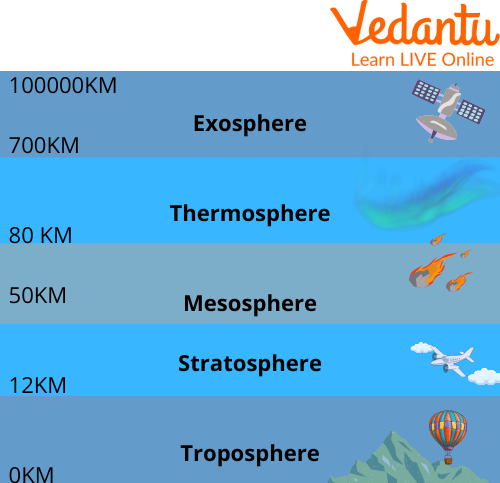




An Overview About Atmosphere
When you stand outside and gaze up, what do you see? Is that a blue sky? A swarm of clouds? You might be wondering, what is the atmosphere? An atmosphere is a layer of gas or layers of gases that envelop a planet and is held in place by the gravity of the planetary body. A planet holds an environment when the gravity is perfect and the temperature of the air is low.
While oxygen is required for most life on Earth, it does not make up the majority of the atmosphere. The Earth's atmosphere is made up of roughly 78% nitrogen, 21% oxygen, 0.9% argon, and 0.1% other gases. Other gases that make up the remaining 0.1 percent include trace amounts of carbon dioxide, methane, water vapour, and neon. In this article, we are going to learn about the atmosphere.

Atmosphere
Atmosphere and Its Layers
An atmosphere is a layer of gas or layers of gases that envelope a planet. One of the main components of Earth's atmosphere is the air. Air is the mixture of gases present on a planet or other heavenly body such as our earth.
Earth's air is made out of around 78% nitrogen, 21% oxygen, and 1% different gases. These gases are trapped in atmospheric layers. The troposphere is the thinnest layer of the atmosphere. The environment safeguards life on earth by protecting it from approaching bright (UV) radiation, keeping the planet warm, and forestalling limits among constant temperatures. Based on temperature, the atmosphere is separated into five different layers.
Troposphere
It is the thinnest layer of the atmosphere which has 80% mass of the air. The climate changes such as heavy rain and lightning happen the most in this part of the layer. Likewise, aeroplanes fly in this layer. Starting from ground level, it extends 10 km in the upward direction above sea level. We live in the troposphere. When we go higher in the troposphere, the temperature gets colder.
Stratosphere
It is the next layer to the troposphere. The Stratosphere reaches out as much as 50 Kilometres above the ground. This layer contains the majority of the ozone gas, which shields us from the UV radiation of the Sun. It contains the ozone layer which protects us from UV radiation which can cause cancer.
Mesosphere
It is the layer above the stratosphere. It reaches upward around 50 kilometres further. The mesosphere has the coldest temperature among all the layers of the environment. The temperature gets colder as you go high up in the mesosphere.
Thermosphere
The layer above the mesosphere is the thermosphere. It is the second highest layer of the atmosphere that absorbs harmful radiation from the Sun. Due to this phenomenon, this layer is also very hot.
Exosphere
The exosphere is the top layer, which merges with what is regarded as outer space. Here, the gravitational pull of Earth is so weak that gas molecules can escape into space. It is the second thinnest layer of the atmosphere after the troposphere.

Atmosphere Information
Ozone Layer
The ozone layer is the layer in the stratosphere that absorbs most of the UV rays. Its chemical formula is O₃. It acts as a shield to the earth.
This layer is gradually depleting because of the use of chlorofluorocarbons. The use of ACs, refrigerators, etc. is becoming a major cause of ozone depletion. Ozone depletion is a major threat to our planet because it can cause glaciers to melt. It also increases the risk of skin cancer due to solar radiation.
Benefits of Atmosphere to Living Beings
The atmosphere protects us from deadly radiation from space and helps to moderate our temperature by preventing sunlight from reaching Earth's surface, which would make things very hot. The atmosphere also traps heat near Earth’s surface, which helps produce pleasant climates. Without an atmosphere, life on Earth could not exist as we know it because then it would be too cold in regions near the poles and too hot at more equatorial latitudes.
Interesting Facts About the Atmosphere
Some of the interesting facts about the atmosphere include the following:
The densest part of the atmosphere only extends to about 20km above the ground. It is a very thin slice compared to the diameter of the Earth, which is 12,472 km.
The atmosphere’s composition has changed over millions of years because of volcanic and microbial activity.
The atmosphere holds the all-important Oxygen that all living organisms need to breathe.
Without the atmosphere protecting us from the Sun’s UV rays, we would have severe sunburns. It also shields us from meteorites and space rocks that come to Earth at high speeds.
Summary
From the above information about the atmosphere, we have learnt that the atmosphere contains greenhouse gases which retain Sun-powered radiation and intensity on our Earth during the evening. We also gained information about different layers of the atmosphere as well as the thinnest and thickest atmospheric layers. We also learned some interesting facts about the atmosphere and how it protects us from Sun-powered harmful radiation. In case of further doubts, read our other article based on this topic.
FAQs on Facts About the Atmosphere
1. What is the importance of the atmosphere for life on Earth?
The atmosphere is crucial for life on Earth in several ways. It provides the oxygen we breathe, regulates the planet's temperature through the greenhouse effect, and contains the ozone layer, which protects all living things from the Sun's harmful ultraviolet (UV) radiation. It also burns up most meteoroids before they can hit the surface.
2. What are the main components of Earth's atmosphere?
The Earth's atmosphere is a mixture of several gases. The main components are:
- Nitrogen (N₂): about 78%
- Oxygen (O₂): about 21%
- Argon (Ar): about 0.93%
- Carbon Dioxide (CO₂): about 0.04%
It also contains trace amounts of other gases like neon, helium, and methane, along with water vapour and dust particles.
3. What are the different layers of the atmosphere?
The atmosphere is divided into five main layers based on temperature changes. From the ground up, they are:
- Troposphere: Where we live and where most weather occurs.
- Stratosphere: Contains the ozone layer that absorbs UV radiation.
- Mesosphere: The layer where most meteors burn up.
- Thermosphere: A very thin layer with extremely high temperatures. The aurora borealis occurs here.
- Exosphere: The outermost layer, where the atmosphere merges into outer space.
4. How are clouds formed in the atmosphere?
Clouds are formed through a process of evaporation and condensation. First, water from oceans, rivers, and lakes evaporates and rises into the atmosphere as warm, moist air (water vapour). As this air rises, it cools down. At cooler temperatures, the invisible water vapour condenses into tiny visible water droplets or ice crystals, which cling to dust particles in the air to form a cloud.
5. What is the main difference between weather and climate?
The main difference between weather and climate is the timescale. Weather refers to the short-term conditions of the atmosphere at a specific time and place, such as temperature, humidity, and rainfall for today or this week. In contrast, climate describes the average weather pattern for a particular region over a very long period, typically 30 years or more.
6. Why does the sky appear blue on a clear day?
The sky appears blue because of a phenomenon called Rayleigh scattering. Sunlight is composed of all the colours of the rainbow. When sunlight enters Earth's atmosphere, the gases and particles in the air scatter the shorter, smaller waves of blue and violet light in all directions more than they scatter the other colours. Our eyes are more sensitive to blue light, so we perceive the sky as blue.
7. What is the difference between ozone depletion and global warming?
Ozone depletion and global warming are two distinct environmental issues. Ozone depletion refers to the thinning of the ozone layer in the stratosphere, primarily caused by man-made chemicals like chlorofluorocarbons (CFCs). This allows more harmful UV radiation to reach Earth. Global warming is the long-term heating of Earth's climate system due to the trapping of heat by greenhouse gases, like carbon dioxide, in the atmosphere.
8. What is the greenhouse effect, and is it always harmful?
The greenhouse effect is not always harmful; in fact, the natural greenhouse effect is essential for life. It's a natural process where certain gases in the atmosphere trap some of the Sun's heat, keeping our planet warm enough to live on. The problem is the enhanced greenhouse effect, where human activities release extra greenhouse gases, trapping too much heat and causing the Earth's average temperature to rise, which leads to climate change.
9. How does atmospheric pressure influence weather patterns?
Atmospheric pressure is the weight of the air above us, and it significantly influences weather. Areas of high pressure are generally associated with calm, clear skies as the air sinks. In contrast, areas of low pressure, where air rises, often lead to cloud formation, wind, and precipitation like rain or snow. Wind itself is simply the movement of air from high-pressure areas to low-pressure areas.





















